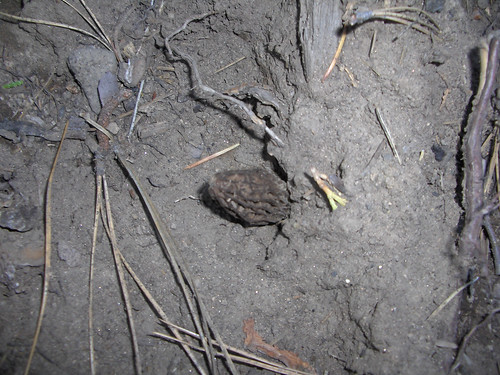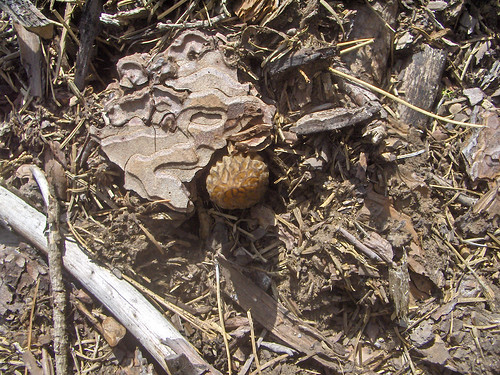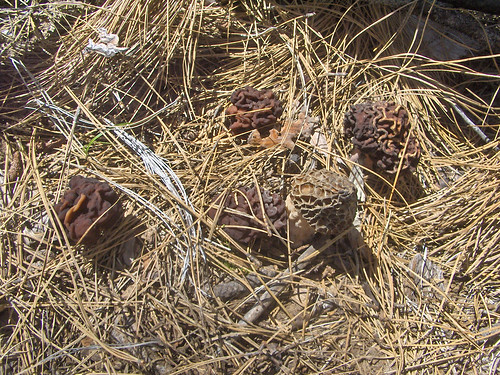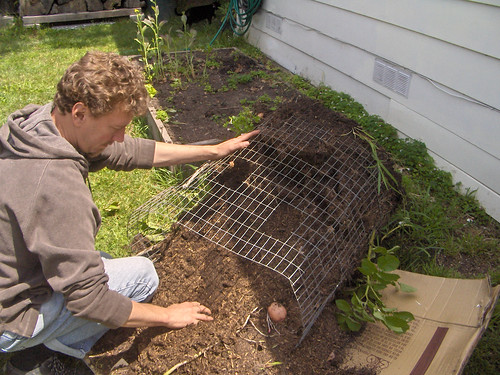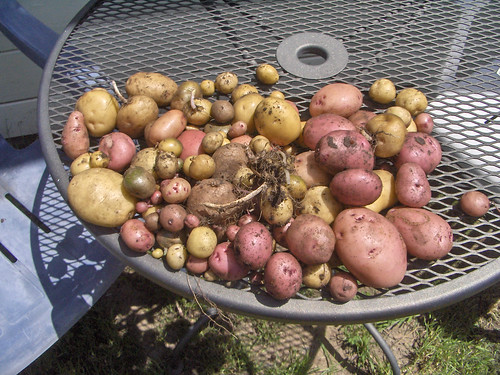Prep vs Packet:
For my first backpacking trip to Kauai, I had a hiking partner - and the two of us decided that for efficiency's sake, we wanted to use some prepared camp meals. I ordered a dozen or so vegan meals in biodegradable/burnable packets from
Mary Jane's Outpost - but we got rained out so the meal packets returned home with me. Last summer, I decided to use up the meals on my 2 week long trip to Portland & back. Unlike the usual car camping trips, I wanted to bring stuff that would be relatively easy to put together.
Mary Jane's Outpost has some good options - and lots of vegan stuff. The packets I brought along included: brownies, griddle cakes, ginger sesame pasta, corn ad, corn salsa, falafel, and lebanese peanut bulghar. The main problem with some of her offerings is that they contain dairy and beans - two foods to which I am allergic. The brownies were the one item that most impressed me but the rehydrated pasta didn't have the right mouth-feel. For the most part, none of these items were all that difficult for me to put together on my own. Falafel mixes can be had anywhere (and I can't eat a lot of that anyway due to the garbanzo flour). Couscous and mushrooms? Just why bother with all the packets?
For this trip, I decided to focus on using fresh, seasonal ingredients that I could dehydrate and which would be satisfying when rehydrated. The most helpful cookbook was the one that talked the most about the processes involved in dehydrating food and how to use it. My food supplies and meals had to conform to these principals:
- Whole foods - similar to how I cook at home. I wanted to avoid pre-packaged processed foods with long lists of ingredients entirely. I don't eat like that at home - and don't want to eat like that on the trail.
- Prep & pack foods that dehydrate well and weigh little, avoid bringing too many liquid condiments (dressings, vinegar, etc).
- Avoid over-relying on processed starches like pasta, couscous and bread. Couscous and pasta are filling and a great source of carbs - but vegetables are key to other nutrients and allow the body to build protein needed by active people! Quinoa was to be my main carb/protein base food, along with whole wheat udon noodles and rice noodles.
- Avoid foods that take too long to cook and thus require more fuel, like rice.
- Flavor foods generously with dried herbs & spices.
- Include foods that replace salts/magnesium lost to sweat while hiking and exercising outdoors - dried seaweeds are great for this purpose.
- Foods should be packaged so they can be used in multiple recipes - dried zucchini, carrots, mushrooms & onions all work pretty well in many different recipes. My magic number was 3 - I would just come up with ideas for different dishes and food combinations for each food, but did not establish this as a hard and fast requirement.
Building in Flexibility:
Most backcountry cookbooks don't take into consideration scalability and the incorporation of locally sourced or volunteered ingredients. In any kind of camping situation - well, let's face it - humans are social animals. We like to congregate in the dark over fire and share food together.
No matter where you go, someone's going to suggest sharing food or even a camping potluck. It's not just a matter of throwing all your extra food in a pot and hoping it comes out right (even if folks say it does, doesn't make it true).
And you might find some amazing local contribution like key limes or Mexican oregano or a mango. Flexibility and creativity are essential to fun and delicious backcountry cooking.
I had some ideas for favorite camping meals and new stuff that might be fun to try - and the book I liked most gave me a few ideas for experimentation. I would probably have tested a few things out before going on the trail, but there were no disasters and I ended up making some pretty awesome food, and was able to share with folks several times with ingredients that weren't terribly expensive but which provided excellent results.
Supply List:
In no particular order - here is a list of the food that I prepared and brought with me - in the backpack - as the bases for meals on the trail.
Fruits & vegetables: hey, I'm a vegetarian! this makes up the bulk of my diet at home, so why not on the trail? I don't eat out of packages at home - so why eat packaged food on the trail?
- Persimmons - 1lb home dehydrated slices
- Apples - 1/2 lb home dehydrated/cored slices
- Strawberries - thinly sliced & home dehydrated (2 pints fresh)
- Apples - sliced & home dehydrated (what I had left from last fall - about 4 cups dried but lotso air!)
- Blueberries - home dehydrated whole (1/2 pint fresh)
- Raspberries - home dehydrated whole (1/2 pint fresh)
- Mushrooms - dried porcini & shitake mushrooms from Mountain Rose Herbs - dried mushrooms are indispensable!
- Onion - 1 red, 1/4" dice
- Onion - 1 yellow, 1/4" dice - both kinds of onions turned out very well rehydrated and in all dishes.
- Carrots - 4 large, 1/4" dice - the carrots got so very tiny! I may just try slices or bigger chunks. They worked out great.
- Zucchini - 4-5 courgettes, 1/4" dice -they looked like shrinky dinks and got way smaller than I expected! These could be added soup, gravy, sauteed with other vegetables. They rehydrated really nicely and were very delicious.
- Sweet potatoes - 3 bigger than a handful each. These were sliced, steamed and mashed in the ricer before being dehydrated. Sweet potatoes reabsorb moisture from the air pretty quickly, so I had to run them through the dehydrator a second time and then powdered the mashed dried sweet potato in my Breville blender
 . I got a very fine powder which imagined would be used in at least three preparations:
. I got a very fine powder which imagined would be used in at least three preparations:
- blending into regular flaked potatoes for mashed potatoes
- rehydrated thickly and sauteed as sweet potato pancakes/latkes
- mixed in with peanut butter and veggies for a soup
- Red bell pepper - 2 large, 1/4" dice & dehydrated (also super shrinky dink!) Bell peppers rehydrate nicely and add great flavor to anything.
Prepared foods: can't get away entirely without without using some prepared foods!
- Potato flakes - about two cups store-bought instant organic potato flakes. Let's face it - mashed potatoes are very satisfying - as mashed potatoes, soup or as soup thickener. Who needs an excuse here?
- Vegan vegetable bouillion cubes - 2 packages of 8 cubes
- Seaweed: 1 package of wakame - provides sodium, magnesium & calcium
- Roasted black sesame seeds
- Udon noodles
- Rice stick noodles
- Quinoa, black (2 cups dried)
- Maple sugar, granulated (1/2 cup)
- Tofu - home dehydrated 8 oz 1/2" cubed tofu. It did not rehydrate - not even after soaking for a billion years and being simmered in soup. It was hard and inedible. Time for more dried tofu experimentation.
- Lara bars
 & Bumble bars
& Bumble bars - 6-8 bars for eating on the plane or in transit or as emergency backup.
- 6-8 bars for eating on the plane or in transit or as emergency backup.
- Mixed raw cashews & almonds.
Packing & Storage:
One of the things that I didn't like about all the backcountry cookbooks I read was that they called for a lot of plastic bags. A lot. Like - pre-measuring out and mixing a ton of things and keeping them separated in a lot of little bags. Or bringing lots of little plastic condiment packets - or worse - small bottles with tons of liquid condiments.
Instead, I wanted to just put like ingredients into larger bags - using mostly wax paper bags (compostable or burnable), which I rolled up, secured with rubber bands and put into 3 larger ziploc bags. I like to use a variety of seasonings and despite any potential weight issue, I don't think I would travel without at least one
spice wheel in my pack.
Pre-Trail Shopping
Depending on how you travel, you may need to pick up a few items! Since I was flying to Kauai, I had to build a list of a few items that I couldn't bring in my carry-on:
- olive oil
- a small knife (which I didn't really need that much)
- coffee (I figured I should just buy local coffee since I would be in Hawaii)
- stove fuel
- 1 pint each of Frangelico & rum - transferred to 16 oz water bottles. Hey, I was on vacation and a girl's got to be able to doctor her morning decaf coffee once in a while!



